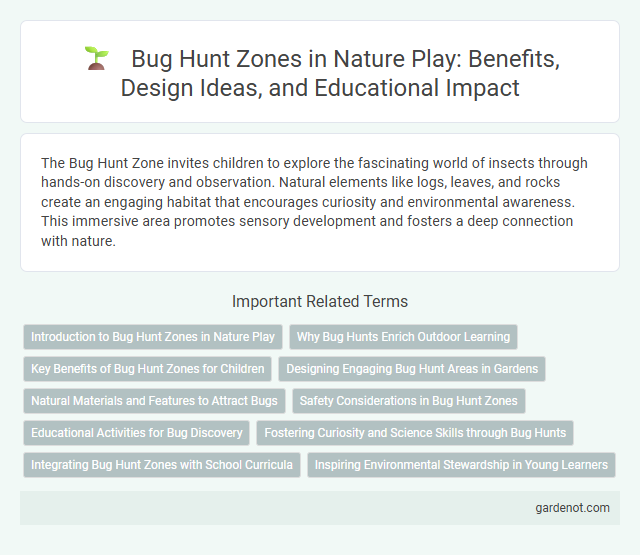The Bug Hunt Zone invites children to explore the fascinating world of insects through hands-on discovery and observation. Natural elements like logs, leaves, and rocks create an engaging habitat that encourages curiosity and environmental awareness. This immersive area promotes sensory development and fosters a deep connection with nature.
Introduction to Bug Hunt Zones in Nature Play
Bug Hunt Zones in nature play offer immersive opportunities for children to explore diverse insect habitats and develop curiosity about ecology. These designated areas are designed with natural elements like logs, leaves, and soil to encourage hands-on discovery and observation of various bug species. Engaging with Bug Hunt Zones fosters environmental awareness and nurtures sensory and cognitive skills through interactive outdoor learning.
Why Bug Hunts Enrich Outdoor Learning
Bug Hunts enrich outdoor learning by promoting hands-on exploration and fostering curiosity about biodiversity. Engaging with insects enhances observational skills and teaches ecological relationships, supporting science literacy in real-world contexts. This immersive experience encourages environmental stewardship, connecting children with nature's intricate systems.
Key Benefits of Bug Hunt Zones for Children
Bug Hunt Zones enhance children's sensory development by engaging them in hands-on exploration of diverse insects and their habitats. These areas foster critical thinking and scientific curiosity through observation and identification activities. Exposure to natural environments in Bug Hunt Zones promotes environmental stewardship and a lifelong appreciation for biodiversity.
Designing Engaging Bug Hunt Areas in Gardens
Designing bug hunt zones in gardens involves creating diverse microhabitats with native plants, logs, and leaf litter to attract a variety of insects such as ladybugs, beetles, and butterflies. Incorporating features like shallow water sources and small rock piles enhances habitat complexity, encouraging children to explore and learn about insect biodiversity. These elements promote hands-on engagement, fostering curiosity and ecological awareness through direct interactions with nature.
Natural Materials and Features to Attract Bugs
The bug hunt zone incorporates natural materials such as logs, rocks, and leaf litter to create authentic habitats that attract various insect species. Features like damp soil patches, flowering plants, and decaying wood provide essential resources for bugs, encouraging biodiversity and interactive exploration. This environment enhances hands-on learning by allowing children to observe and engage with insects in their natural settings.
Safety Considerations in Bug Hunt Zones
Bug hunt zones should be designed with non-toxic plants and safe, natural materials to minimize risks of allergic reactions or poisoning. Clear signage and supervision help prevent children from handling harmful insects or disturbing fragile ecosystems. Ensuring safe boundaries and regular maintenance reduces hazards like sharp objects, uneven terrain, and exposure to harmful insects.
Educational Activities for Bug Discovery
The Bug Hunt Zone offers immersive educational activities designed to promote hands-on learning about insect behavior, habitats, and biodiversity. Participants engage in guided exploration using magnifying tools to observe bug anatomy and ecological roles in real time. Interactive workshops enhance knowledge retention by combining sensory experiences with scientific inquiry, fostering curiosity and environmental stewardship in children and adults alike.
Fostering Curiosity and Science Skills through Bug Hunts
Bug hunt zones encourage children to explore diverse insect species, enhancing observational skills and fostering scientific curiosity. Engaging with natural habitats promotes critical thinking and hands-on learning, essential for developing foundational science skills. This interactive discovery process supports ecological awareness and a deeper understanding of biodiversity.
Integrating Bug Hunt Zones with School Curricula
Integrating Bug Hunt Zones into school curricula enhances experiential learning by aligning outdoor exploration with scientific standards in biology and environmental science. Students engage in hands-on observation and identification of local insect species, promoting curiosity and developing critical thinking skills while reinforcing classroom concepts. This approach supports STEM education by fostering ecological literacy and encouraging sustainable practices from an early age.
Inspiring Environmental Stewardship in Young Learners
The Bug Hunt Zone engages young learners in hands-on exploration, fostering awareness of diverse insect species and their vital roles in ecosystems. Observing bugs in their natural habitats cultivates curiosity and respect for biodiversity, encouraging conservation-minded behaviors from an early age. This interactive experience lays a foundation for lifelong environmental stewardship by connecting children directly with nature's intricate web.
Bug hunt zone Infographic

 gardenot.com
gardenot.com